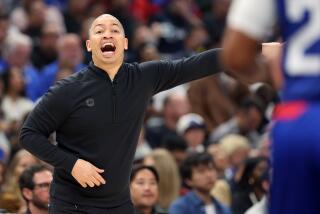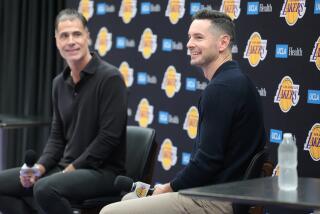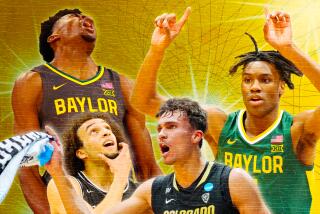Picking First Doesn’t Mean Picking Best : NBA draft: Some of West’s gambles (Green, Divac) have paid off. Some of Clippers’ sure things (Williams, Ferry) haven’t.
- Share via
It’s draft time in the NBA, when the losers become winners and the winners become gamblers.
Nowhere is that more evident than locally, where the city’s two teams briefly trade places.
For one day at least, the Clippers, seemingly permanent contestants in the NBA lottery, grab the local spotlight and headlines with a pick at or near the top.
For the Lakers, on the other hand, Showtime becomes low time.
Success has its price and, for the Lakers, victory over a decade of domination has meant picking at or near the bottom in one draft after another.
It’s no different this time. The Clippers draft eighth with their own pick and 13th with a choice they got from the Cleveland Cavaliers in the Ron Harper trade.
The Lakers, thanks to a league-high 63 victories, pick last, getting the 27th choice.
Actually, because of expansion, it keeps getting worse for the Lakers. Until several years ago, even the last choice was the 23rd. But with four new teams--Charlotte, Miami, Orlando and Minnesota--the top clubs keep moving farther to the rear.
Even so, Laker General Manager Jerry West says he hasn’t lost his optimism.
“You have to have a different attitude where we pick,” West said. “If you don’t think you can get anyone, it would be pretty depressing to draft there every year. You have to get a player. Otherwise, you’ve just wasted a year. You have to stay optimistic.”
Even if your phone rarely rings.
“Nobody is calling you to trade for your pick,” he said. “Where we are, all people want to know is if we want to move up to the spot above.”
But a lack of opportunity to draft a blue chipper doesn’t keep West and his staff from spending long hours trying to find a hidden gem.
Knowing the players with the flashy numbers will be long gone when the Lakers’ name is called, what does West look for in a prospect?
“We want to know, how does he play the game?” West said. “Does he know how to play the game? Does he have the ability to not be selfish? Players picked down there have to work harder.”
West estimates that the two Laker scouts, Ronnie Lester and Gene Tormohlen, see 100 college games a year. West himself sees about 60, and, when home, watches two a night on television.
It’s a challenge that West, despite the odds, has met more than once. Over the last five years, the Lakers have had four first-round picks, all near the bottom. Two of those, A.C. Green in 1985 and Vlade Divac last year, have been successful enough to cause some hand-wringing for those who passed on them earlier.
Although he was the Pacific 10 Conference player of the year as a junior at Oregon State, Green was still available when the Lakers selected 23rd. Green averaged just 14.7 points and 7.7 rebounds a game in four seasons as a Beaver.
“Oregon State didn’t shoot much,” West said. “But you had to be impressed with (Green’s) work ethic.”
With that work ethic, Green eventually elbowed Kurt Rambis out of the starting power forward’s job.
Last year, with Kareem Abdul-Jabbar leaving and the Lakers stuck in the 26th slot of the draft without much realistic hope of getting a bona fide center, West held his breath as the player he wanted kept going unclaimed.
When the Lakers’ turn came and Divac, a 7-1 raw talent from Yugoslavia with intriguing potential, was still there, West couldn’t say his name fast enough.
“I think he slid down there because some people might have been afraid of the political problems in getting him, or adjustments he was going to have to make here in this country,” West said. “We got lucky because people would rather take an American.”
The Lakers’ other top picks of the last five years didn’t work out quite so well. With the 23rd choice in the 1986 draft, they selected Ken Barlow of Notre Dame, then immediately traded him, along with Mike McGee, to the Atlanta Hawks for Billy Thompson and Ron Kellogg, neither of whom stuck.
In 1987, the Lakers didn’t have a first-round pick, having given it to the San Antonio Spurs in the deal for Mychal Thompson. With their first selection in the third round, the Lakers picked the forgettable Willie Glass of St. John’s.
In 1988, they had the 25th selection, using it to take David Rivers of Notre Dame, another soon-to-disappear Laker.
The Clippers’ problem has never been getting top picks, just keeping them. Over the last five years, the club has had eight first-round selections, seven in the last three seasons.
Their biggest disappointments have been their first pick each time. Over the last five seasons, the Clippers have selected one who played only when he wanted to, one who didn’t want to play at all, one who wanted to play but couldn’t and two who wanted to play but weren’t good enough.
The record:
--1985: The Clippers use the third pick of the draft to take Creighton center Benoit Benjamin. What follows is five years of frustration and anger as Benjamin battles his critics, management, fans and even fellow players because of an attitude he later admits was immature. He is often out of shape and out of touch. Only recently has he begun to realize some of the potential the Clippers saw half a decade ago.
--1986: Without a draft choice in the first two rounds, the Clippers select Dwayne Polee of Pepperdine in the third round. He plays one game for the Clippers.
--1987: With the fourth pick overall, the Clippers select swing man Reggie Williams of Georgetown. After 2 1/2 years of ineffectiveness, he is shipped to Cleveland in the Ron Harper deal.
--1988: With the first pick in the draft, the Clippers figure they can’t go wrong with forward Danny Manning, the player of the year the previous season after leading Kansas to the NCAA championship. But, the hex of the Clippers catches up to him midway through his first season. A knee injury knocks him out for nearly 11 months.
--1989: The Clippers have the second pick overall. When the Sacramento Kings use the first choice to take Pervis Ellison, it appears the Clippers’ luck has finally changed. With the second pick, they can have the first choice of most draft observers, forward Danny Ferry of Duke. The Clippers select him but Ferry plays in Italy rather than join this hapless club.
Two of the other first-round Clipper picks over the last five years--forward Charles Smith and guard Gary Grant--came to the club in a 1988 draft-day, three-team deal involving the Philadelphia 76ers and Seattle Supersonics. Smith has become the Clippers’ most consistent player, averaging 21.1 points and 6.7 rebounds last season. Grant was averaging double figures in both points, 13.1, and assists, 10, when an ankle injury ended his season in February.
After selecting Williams in 1987, the Clippers took Joe Wolf with the 13th pick and Ken Norman with the 19th. Norman averaged 16.1 points last season, mostly at small forward. Wolf, also a forward, averaged 17.2 minutes, 4.8 points, and 3.0 rebounds.
More to Read
Get our high school sports newsletter
Prep Rally is devoted to the SoCal high school sports experience, bringing you scores, stories and a behind-the-scenes look at what makes prep sports so popular.
You may occasionally receive promotional content from the Los Angeles Times.






